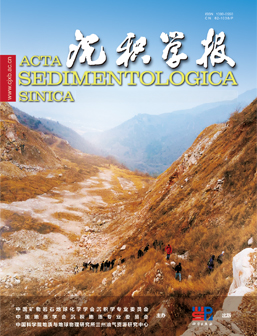Reservoir diagenesis, pore evolution and oil and gas charging in the fourth member of Sinian Dengying Formation in Penglai area, central Sichuan
doi: 10.14027/j.issn.1000-0550.2024.012
- Received Date: 2023-11-16
- Available Online: 2024-03-11
-
Key words:
- Penglai Area /
- fourth member of Dengying Formation /
- Diagenesis /
- Pore evolution /
- Oil-gas charging
Abstract: [Objective]Dengying Formation in Penglai area of central Sichuan has achieved a major breakthrough in exploration, but the fourth member of Dengying Formation has experienced multiple stages of oil and gas charging due to its large burial depth, old age and complex diagenetic evolution, the relationship between reservoir pore evolution and oil and gas charging is still unclear. [Methods]Based on drilling coring data, the petrological types, reservoir space characteristics, diagenetic types, diagenetic evolution sequence, pore evolution and hydrocarbon charging of the fourth member of Dengying Formation were studied by means of thin section observation, cathodoluminescence, in situ microelement analysis and fluid inclusion. [Results and Discussions]The reservoir rock types of the fourth member of Dengying Formation in Penglai area are mainly crystalline dolomite, granular dolomite and microbial dolomite. The types of reservoir space can be divided into three types: cave, pore and fracture. The main diagenetic types are syngene-parsyngenetic dissolution, epigenetic dissolution, buried dissolution, cementation and filling, tectonic rupture, silicification and compaction. Diagenesis in different stages jointly controls the evolution of reservoir pores in the four members of Dengying Formation, among which the constructive diagenesis is dissolution and rupture in different periods, and the destructive diagenesis is compaction and pressure-dissolution and cementation and filling.[Conclusion] The filling sequence of cement in the solution holes of the fourth member of the reservoir can be divided into: the first generation blade-like dolomite → the second generation powdery dolomite → the first stage bitumen → the third generation fine crystalline dolomite → the fourth generation medium crystalline dolomite → the fifth generation coarse crystalline dolomite → the sixth generation giant crystalline saddle-shaped dolomite → the second stage bitumen → the seventh generation quartz, fluorite and other minerals. According to the information of fluid inclusions captured by cemented fill of each stage, such as type, phase state and homogenization temperature, the oil-gas charging process of Dthe fourth member of Dengying Formation in Penglai Area was reconstructed: Paleo-oil reservoir charging in the middle and late Silurian period (the first phase of fossil oil reservoir) → late Caledonian paleo-oil reservoir destruction → Middle Triassic paleo-oil reservoir charging (the second phase of fossil oil reservoir) → Late Jurassic paleo-gas cracking in paleo-oil reservoir → the adjustment and formation of paleo-gas reservoir from Late Cretaceous to present, in which the late oil cracking gas → gaseous hydrocarbon charging is the main forming period of the fourth member gas reservoir of Dengying Formation.
| Citation: | Reservoir diagenesis, pore evolution and oil and gas charging in the fourth member of Sinian Dengying Formation in Penglai area, central Sichuan[J]. Acta Sedimentologica Sinica. doi: 10.14027/j.issn.1000-0550.2024.012 |






 DownLoad:
DownLoad: